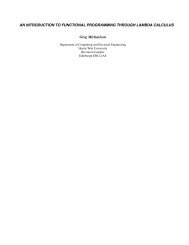Contents
Contents
Contents
You also want an ePaper? Increase the reach of your titles
YUMPU automatically turns print PDFs into web optimized ePapers that Google loves.
AMATH 581 ( c○J. N. Kutz) 9is O(∆t 4 ). The key to this method, as well as any of the other Runge-Kuttaschemes, is the use of intermediate time-steps to improve accuracy. For the4th order scheme presented here, a graphical representation ofthisderivativesampling at intermediate time-steps is shown in Fig. 2.Adams method: multi-stepping techniquesThe development of the Runge-Kutta schemes rely on the definition of thederivative and Taylor expansions. Another approach to solving (1.1.1) is to startwith the fundamental theorem of calculus [2]. Thus the differential equation canbe integrated over a time-step ∆t to give∫dyt+∆tdt = f(y,t) ⇒ y(t +∆t) − y(t) = f(t, y)dt . (1.1.16)And once again using our iteration notation we findt∫ tn+1y n+1 = y n + f(t, y)dt . (1.1.17)t nThis iteration relation is simply a restatement of (1.1.7) with ∆t·φ = ∫ t n+1t nf(t, y)dt.However, at this point, no approximations have been made and (1.1.17) is exact.The numerical solution will be found by approximating f(t, y) ≈ p(t, y) wherep(t, y) isapolynomial.Thustheiterationschemeinthisinstancewill be givenby∫ tn+1y n+1 ≈ y n + p(t, y)dt . (1.1.18)t nIt only remains to determine the form of the polynomial to be used in theapproximation.The Adams-Bashforth suite of computational methods uses the current pointand a determined number of past points to evaluate the future solution. Aswith the Runge-Kutta schemes, the order of accuracy is determined by thechoice of φ. In the Adams-Bashforth case, this relates directly to the choiceof the polynomial approximation p(t, y). A first-order scheme can easily beconstructed by allowingp 1 (t) =constant=f(t n , y n ) , (1.1.19)where the present point and no past points are used to determine the value ofthe polynomial. Inserting this first-order approximation into (1.1.18) results inthe previously found Euler schemey n+1 = y n +∆t · f(t n , y n ) . (1.1.20)
















